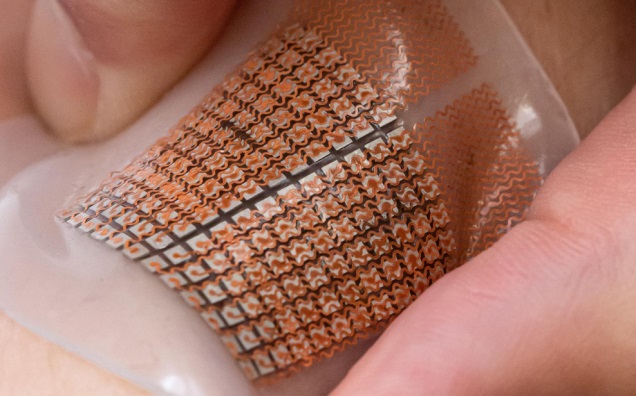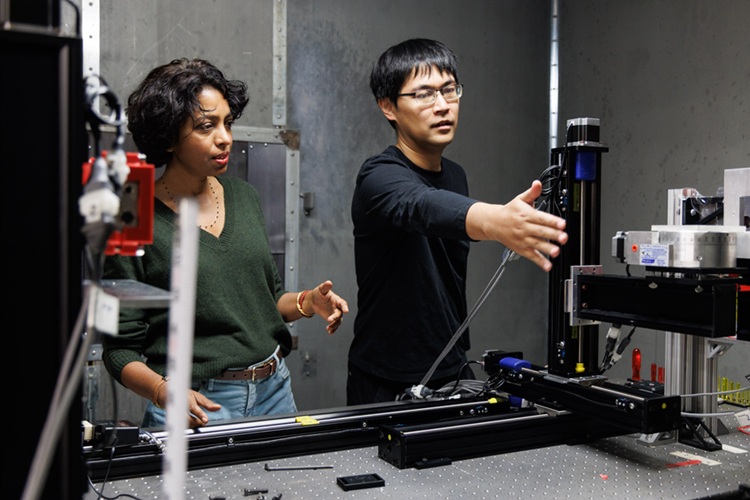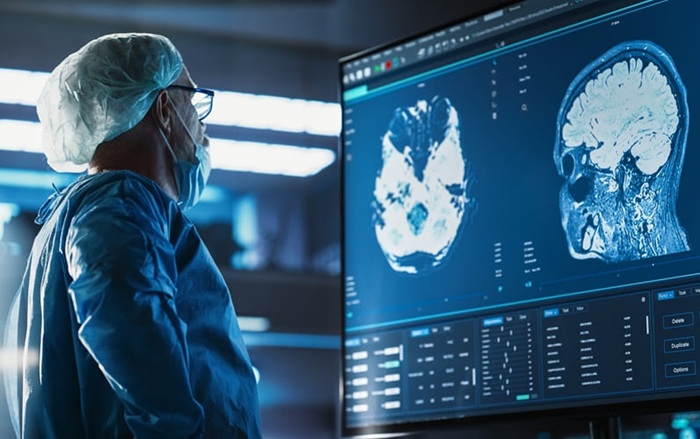Flexible Ultrasound Patch Monitors Cardiovascular Function
|
By MedImaging International staff writers Posted on 12 Aug 2021 |

The phased array ultrasound transducer patch (Photo courtesy of UCSD)
A novel wearable skin patch that incorporates an array of ultrasonic transducers can provide continuous monitoring of deep-tissue hemodynamics, claims a new study.
Developed at the University of California, San Diego (UCSD; USA), Yonsei University (Seoul, South Korea), the Korea Institute of Science and Technology (KIST; Seoul, Republic of Korea), and other institutions, the patch is made of a flexible, stretchable polymer that that is embedded with a 12X12 grid of millimeter-sized ultrasound transducers, in a phased array design. When electricity flows through the transducers, they emit ultrasound waves that travel through the skin and deep into the body.
The computerized phased array design has two main modes of operation. In one, the transducers are synchronized to transmit ultrasound waves together, producing a high-intensity ultrasound beam that focuses on one spot up to 14 centimeters in the body. In the other mode, the transducers can be programmed to transmit out of sync, allowing for active focusing and steering of ultrasound beams over a range of incident angles so as to target various regions of interest. When the waves penetrate through a major blood vessel, they encounter movement from red blood cells (RBCs) flowing inside.
These movement changes or shifts, known as Doppler frequency shift, reflect back to the patch, and are used to create a visual recording of the blood flow. This same mechanism can also be used to create moving images of the heart’s walls. In a study conducted in healthy volunteers, the phased array patch monitored Doppler spectra from cardiac tissues, recorded central blood flow waveforms, and estimated cerebral blood supply in real time. The study was published on July 16, 2021, in Nature Biomedical Engineering.
“Sensing signals at such depths is extremely challenging for wearable electronics. Yet, this is where the body’s most critical signals and the central organs are buried,” said co-first author nanoengineer Chonghe Wang, PhD, of UCSD. “We engineered a wearable device that can penetrate such deep tissue depths and sense those vital signals far beneath the skin. This technology can provide new insights for the field of healthcare.”
Related Links:
University of California
Yonsei University
Korea Institute of Science and Technology
Developed at the University of California, San Diego (UCSD; USA), Yonsei University (Seoul, South Korea), the Korea Institute of Science and Technology (KIST; Seoul, Republic of Korea), and other institutions, the patch is made of a flexible, stretchable polymer that that is embedded with a 12X12 grid of millimeter-sized ultrasound transducers, in a phased array design. When electricity flows through the transducers, they emit ultrasound waves that travel through the skin and deep into the body.
The computerized phased array design has two main modes of operation. In one, the transducers are synchronized to transmit ultrasound waves together, producing a high-intensity ultrasound beam that focuses on one spot up to 14 centimeters in the body. In the other mode, the transducers can be programmed to transmit out of sync, allowing for active focusing and steering of ultrasound beams over a range of incident angles so as to target various regions of interest. When the waves penetrate through a major blood vessel, they encounter movement from red blood cells (RBCs) flowing inside.
These movement changes or shifts, known as Doppler frequency shift, reflect back to the patch, and are used to create a visual recording of the blood flow. This same mechanism can also be used to create moving images of the heart’s walls. In a study conducted in healthy volunteers, the phased array patch monitored Doppler spectra from cardiac tissues, recorded central blood flow waveforms, and estimated cerebral blood supply in real time. The study was published on July 16, 2021, in Nature Biomedical Engineering.
“Sensing signals at such depths is extremely challenging for wearable electronics. Yet, this is where the body’s most critical signals and the central organs are buried,” said co-first author nanoengineer Chonghe Wang, PhD, of UCSD. “We engineered a wearable device that can penetrate such deep tissue depths and sense those vital signals far beneath the skin. This technology can provide new insights for the field of healthcare.”
Related Links:
University of California
Yonsei University
Korea Institute of Science and Technology
Latest Ultrasound News
- Wearable Ultrasound Imaging System to Enable Real-Time Disease Monitoring
- Ultrasound Technique Visualizes Deep Blood Vessels in 3D Without Contrast Agents
- Ultrasound Probe Images Entire Organ in 4D

- Disposable Ultrasound Patch Performs Better Than Existing Devices
- Non-Invasive Ultrasound-Based Tool Accurately Detects Infant Meningitis
- Breakthrough Deep Learning Model Enhances Handheld 3D Medical Imaging
- Pain-Free Breast Imaging System Performs One Minute Cancer Scan
- Wireless Chronic Pain Management Device to Reduce Need for Painkillers and Surgery
- New Medical Ultrasound Imaging Technique Enables ICU Bedside Monitoring
- New Incision-Free Technique Halts Growth of Debilitating Brain Lesions
- AI-Powered Lung Ultrasound Outperforms Human Experts in Tuberculosis Diagnosis
- AI Identifies Heart Valve Disease from Common Imaging Test
- Novel Imaging Method Enables Early Diagnosis and Treatment Monitoring of Type 2 Diabetes
- Ultrasound-Based Microscopy Technique to Help Diagnose Small Vessel Diseases
- Smart Ultrasound-Activated Immune Cells Destroy Cancer Cells for Extended Periods
- Tiny Magnetic Robot Takes 3D Scans from Deep Within Body
Channels
Radiography
view channel
AI Detects Early Signs of Aging from Chest X-Rays
Chronological age does not always reflect how fast the body is truly aging, and current biological age tests often rely on DNA-based markers that may miss early organ-level decline. Detecting subtle, age-related... Read more
X-Ray Breakthrough Captures Three Image-Contrast Types in Single Shot
Detecting early-stage cancer or subtle changes deep inside tissues has long challenged conventional X-ray systems, which rely only on how structures absorb radiation. This limitation keeps many microstructural... Read moreMRI
view channel
Novel Imaging Approach to Improve Treatment for Spinal Cord Injuries
Vascular dysfunction in the spinal cord contributes to multiple neurological conditions, including traumatic injuries and degenerative cervical myelopathy, where reduced blood flow can lead to progressive... Read more
AI-Assisted Model Enhances MRI Heart Scans
A cardiac MRI can reveal critical information about the heart’s function and any abnormalities, but traditional scans take 30 to 90 minutes and often suffer from poor image quality due to patient movement.... Read more
AI Model Outperforms Doctors at Identifying Patients Most At-Risk of Cardiac Arrest
Hypertrophic cardiomyopathy is one of the most common inherited heart conditions and a leading cause of sudden cardiac death in young individuals and athletes. While many patients live normal lives, some... Read moreNuclear Medicine
view channel
PET Imaging of Inflammation Predicts Recovery and Guides Therapy After Heart Attack
Acute myocardial infarction can trigger lasting heart damage, yet clinicians still lack reliable tools to identify which patients will regain function and which may develop heart failure.... Read more
Radiotheranostic Approach Detects, Kills and Reprograms Aggressive Cancers
Aggressive cancers such as osteosarcoma and glioblastoma often resist standard therapies, thrive in hostile tumor environments, and recur despite surgery, radiation, or chemotherapy. These tumors also... Read more
New Imaging Solution Improves Survival for Patients with Recurring Prostate Cancer
Detecting recurrent prostate cancer remains one of the most difficult challenges in oncology, as standard imaging methods such as bone scans and CT scans often fail to accurately locate small or early-stage tumors.... Read moreGeneral/Advanced Imaging
view channel
AI-Based Tool Accelerates Detection of Kidney Cancer
Diagnosing kidney cancer depends on computed tomography scans, often using contrast agents to reveal abnormalities in kidney structure. Tumors are not always searched for deliberately, as many scans are... Read more
New Algorithm Dramatically Speeds Up Stroke Detection Scans
When patients arrive at emergency rooms with stroke symptoms, clinicians must rapidly determine whether the cause is a blood clot or a brain bleed, as treatment decisions depend on this distinction.... Read moreImaging IT
view channel
New Google Cloud Medical Imaging Suite Makes Imaging Healthcare Data More Accessible
Medical imaging is a critical tool used to diagnose patients, and there are billions of medical images scanned globally each year. Imaging data accounts for about 90% of all healthcare data1 and, until... Read more
Global AI in Medical Diagnostics Market to Be Driven by Demand for Image Recognition in Radiology
The global artificial intelligence (AI) in medical diagnostics market is expanding with early disease detection being one of its key applications and image recognition becoming a compelling consumer proposition... Read moreIndustry News
view channel
GE HealthCare and NVIDIA Collaboration to Reimagine Diagnostic Imaging
GE HealthCare (Chicago, IL, USA) has entered into a collaboration with NVIDIA (Santa Clara, CA, USA), expanding the existing relationship between the two companies to focus on pioneering innovation in... Read more
Patient-Specific 3D-Printed Phantoms Transform CT Imaging
New research has highlighted how anatomically precise, patient-specific 3D-printed phantoms are proving to be scalable, cost-effective, and efficient tools in the development of new CT scan algorithms... Read more
Siemens and Sectra Collaborate on Enhancing Radiology Workflows
Siemens Healthineers (Forchheim, Germany) and Sectra (Linköping, Sweden) have entered into a collaboration aimed at enhancing radiologists' diagnostic capabilities and, in turn, improving patient care... Read more



















